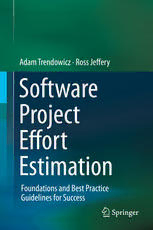
Software Project Effort Estimation: Foundations and Best Practice Guidelines for Success PDF
Preview Software Project Effort Estimation: Foundations and Best Practice Guidelines for Success
Adam Trendowicz · Ross Jeff ery Software Project Eff ort Estimation Foundations and Best Practice Guidelines for Success Software Project Effort Estimation ThiSisaFMBlankPage Adam Trendowicz (cid:129) Ross Jeffery Software Project Effort Estimation Foundations and Best Practice Guidelines for Success AdamTrendowicz RossJeffery FraunhoferInstitutefor TheUniversityofNewSouthWales ExperimentalSoftwareEngineering Sydney Kaiserslautern NewSouthWales Germany Australia ISBN978-3-319-03628-1 ISBN978-3-319-03629-8(eBook) DOI10.1007/978-3-319-03629-8 SpringerChamHeidelbergNewYorkDordrechtLondon LibraryofCongressControlNumber:2014931020 #SpringerInternationalPublishingSwitzerland2014 Thisworkissubjecttocopyright.AllrightsarereservedbythePublisher,whetherthewholeorpart of the material is concerned, specifically the rights of translation, reprinting, reuse of illustrations, recitation,broadcasting,reproductiononmicrofilmsorinanyotherphysicalway,andtransmissionor informationstorageandretrieval,electronicadaptation,computersoftware,orbysimilarordissimilar methodologynowknownorhereafterdeveloped.Exemptedfromthislegalreservationarebriefexcerpts inconnectionwithreviewsorscholarlyanalysisormaterialsuppliedspecificallyforthepurposeofbeing enteredandexecutedonacomputersystem,forexclusiveusebythepurchaserofthework.Duplication ofthispublicationorpartsthereofispermittedonlyundertheprovisionsoftheCopyrightLawofthe Publisher’s location, in its current version, and permission for use must always be obtained from Springer.PermissionsforusemaybeobtainedthroughRightsLinkattheCopyrightClearanceCenter. ViolationsareliabletoprosecutionundertherespectiveCopyrightLaw. The use of general descriptive names, registered names, trademarks, service marks, etc. in this publicationdoesnotimply,evenintheabsenceofaspecificstatement,thatsuchnamesareexempt fromtherelevantprotectivelawsandregulationsandthereforefreeforgeneraluse. While the advice and information in this book are believed to be true and accurate at the date of publication,neithertheauthorsnortheeditorsnorthepublishercanacceptanylegalresponsibilityfor anyerrorsoromissionsthatmaybemade.Thepublishermakesnowarranty,expressorimplied,with respecttothematerialcontainedherein. Printedonacid-freepaper SpringerispartofSpringerScience+BusinessMedia(www.springer.com) Foreword Softwareeffortestimationisoneoftheoldestandmostimportantproblemsfacing softwareprojectmanagement;beingabletoplancorrectlyisthebasisforallproject management activities. One cannot manage a project without the knowledge of whatresourcesareneededtoachievetheprojectgoals.Itisanareawheretherehas beenagreatdealofresearchinthedevelopmentandfine-tuningofnewmodelsand encodingofexperienceinapplyingthesemodels. Today,therearealargenumberofmodels,eachhavingdifferentstrengthsand weaknesses in general and, more importantly, different strengths and weaknesses relative to the environment and context in which they are to be applied, for example,thehistoricaldataavailableandthekindsoffactorsthatarerelevant.At thestartofaproject,itisdifficulttounderstandalltheinfluencingfactorsandrisks; thereisaminimalamountofinformationavailable.Effortneedstobereestimated at various points intime asthe project progresses. And how do youbalance early effortcommitmentagainstnewestimates?Whattrade-offsarepossible? Which models to apply under what conditions is difficult and requires a great deal ofinsight intothe environment.As with allsoftware engineeringapproaches and models, it is critical to understand the context in which the approach is to be applied, the model assumptions and context for which the model was developed (not always made clear by the model developer), and how to apply and tailor the modeltoyourcontext. Thisbookaddressesallthesepointsandprovidesalargesetofmodeltypesand classes, focusing on what you need to understand about your environment, what informationyouneedtobeabletoapplythemodel,whatmodelsaremosteffective foraparticularenvironment,andhowyoucanlearnfromthemodel’sapplicationso youcanevolveandimproveyourmodelovertime. The book is full of insights and useful advice on what to do and how to do it, what to be wary of, and the limitations of effort estimation. Just reading the tips containedineachchapterisavaluableexperience. The book goes beyond effort estimation and provides enormous insights into project management, in general, discussing such issues as project trade-offs, risk assessment,andorganizationallearning. v vi Foreword ThisisthemostcompleteworkonallaspectsofsoftwareeffortestimationthatI have seen and provides an excellent reference for the field. It belongs on the bookshelf of every organization that needs to manage a software project. At the sametime,itisanexcellenttextforauniversitycourseonsoftwareeffortestima- tion,atopicthatistypicallyinsufficientlytreatedinmostcurricula. December2013 VictorR.Basili UniversityofMaryland CollegePark,MD,USA On True Success Past successes, no matter how numerous and universal, are no guarantee of future performanceinanewcontext. –HenryPetroski Failureissuccessifwelearnfromit. –MalcolmForbes Successconsistsofgoingfromfailuretofailurewithoutlossofenthusiasm. –WinstonChurchill To be defeated and not submit, is victory; to be victorious and rest on one’s laurels, is defeat. –Jo´zefPiłsudski(FirstMarshalofPoland) vii ThiSisaFMBlankPage Preface Thetimeforactionisnow.It’snevertoolatetodosomething. —AntoinedeSaint-Exupery. What Is This Book About? In this book, we focus on the estimation of software development effort. Three aspects are considered important for the proper handling of effort estimation: (1) foundations of software effort estimation, (2) selecting the most suitable esti- mationapproach,and(3)successfullyusingeffortestimationinspecificcontexts. What Is This Book NOT About? This book does not include project planning activities that typically follow effort estimation.Wedonotdiscusssuchaspectsashowtoallocateprojectresourcesto work tasks, how to sequence work activities, how to determine critical paths, and howtoresolveresourceconflicts.Finally,wearenotaddressingprojectscheduling or budgeting. We refer readers interested in these subjects to books that address project management topics, for example, the PMI’s (2013) Project Management Body of Knowledge (PMBOK Guide) or OGC’s (2009) PRINCE2, which offer veryusefuloverviewsofcommonprojectmanagementpractices. To Whom Is This Book Addressed? In its very early stage, this book was intended as a collection of notes, where the mostrelevantestimationprinciples,definitions,andempiricalobservations,found intheliteratureandfromexperience,weregathered.Inthecourseoftime,thiswas sharedwithothers.Thisbookaimstoinherittheintentionoftheseinitialnotesand theneedsofpeopletheyweresharedwith.Itisaddressedtothosewhowanttotake ix
